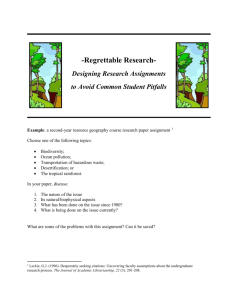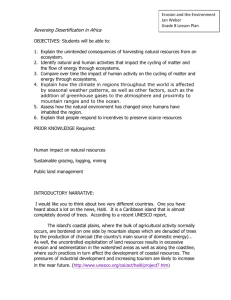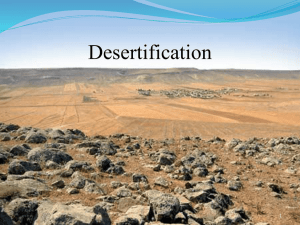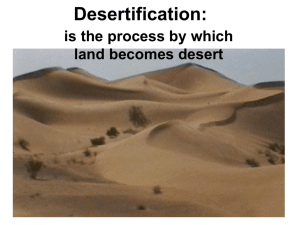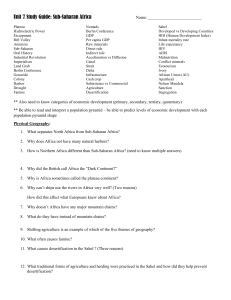lesson 17 - case study
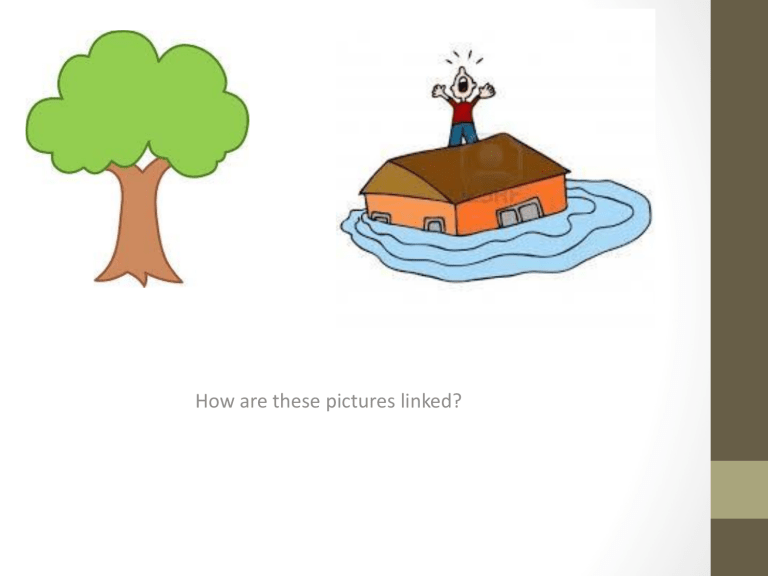
How are these pictures linked?
Desertification Case study
By the end of the lesson you will;
1) Described the causes of desertification in Ghana
2) Have explained how the risk of desertification can be reduced
1) Have applied your new knowledge
HW
• Research how charities have helped to reduce the impacts of drought and desertification.
• Bring in research next lesson to be used in a class discussion
Case study time;
Task
Around the room are a series of fact cards on Ghana
You need to make notes on the case study sheet
You need to answer the following questions
1.
Where is Ghana?
2.
What is the climate of Ghana like?
3.
What are the characteristics of the population?
4.
What are the main trends in the landscape?
5.
How does land management contribute to desertification?
6.
How does commercial farming contribute to desertification?
7.
What do different groups of people thing about commercial farming?
How much can you remember?
Task
1.
Work in a group to remember as much of the diagram as possible
2.
1 minute to remember as much as possible
3.
Non verbal communication
4.
Good luck
Case study Summary
Where is Ghana?
West Africa, east of Cote D’ivoire, and west of Togo
Land management contributing to desertification
Traditionally crops are grown using a bush fallow system
Crops such as maize and root vegetables are grown for 1- 3 years
The land is then left abandoned for 8-15 years
This means that it will regain its fertility as natural shrubs will grow back
This method will work as long as the villagers keep the area uncultivated for the correct period of time
Climate of Ghana;
Northern Ghana is the driest (dry season of 8 months)
It is Savanna forest and grassland
The further south, the more fertile the land
Population of Ghana;
The richest people live in Greater Accra
Generally, the further north travelled, the greater the number of people living under $300
Rural families earn less money than urban families
Commercial farming
Lots of land bought by TNC’s to grow cash crops
The land is now commercial land rather than the traditional bush fallow land
Jatropha is one of the different crops that is grown by companies such as Agroils
Up to 37% of the land is now dedicated to growing this crop
5 million hectares of land is used for
Agribusiness.
Desertification Case study
By the end of the lesson you will;
1) Described the causes of desertification in Ghana
2) Have explained how the risk of desertification can be reduced
1) Have applied your new knowledge
Preventing Desertification;
Key ideas
Task
Watch the following video clip
Answer the following question;
1.
Why has the desert got bigger?
2.
What are they doing to try and reduce the risk of desertification?
3.
How successful has this been?
Acacia trees are planted in areas of desert
They provide nutrients for other plants in the area
Restores fertility of the soil
Natural and found locally
People are educated as to how to reduce the impacts of desertification
Food for animals – reduces risk of overgrazing
Money for locals (don’t cut down trees)
Value the resources rather than cut them down
Aiming to produce a green corridor along the whole of the Sahel region
Preventing Desertification;
Key Schemes
1.
27 million pounds has been given by the Canadian Government to invest in projects to help reduce the impacts of desertification
2.
10,000 saplings have been planted and donated to improve the vegetation cover around the River Volta.
3.
Bunds have been constructed to reduce risk of further desertification
How do you think that these help?
Any water that flows will be trapped
Any soil that is moved by the water will be trapped behind the bund
The trapped moisture will soak into the soil, recharging the soil
Grass is planted on the top to make it more stable
Reducing desertification;
Task
How will each method reduce the impacts of desertification
Link in the key words used in the lesson
Which of the different methods is the most effective?
Method How does it prevent desertification?
Tree planting
Collecting rainwater
Building terraces
Planting grass strips
Building small rock dams
More effective wood stoves
Key words;
Interception
Erosion
Surface run off
Percolation
Precipitation
Aquifer
Evapotranspiration
Roots
Groundwater flow
Leaf drip
Desertification Case study
By the end of the lesson you will;
1) Described the causes of desertification in Ghana
2) Have explained how the risk of desertification can be reduced
1) Have applied your new knowledge
Applying new knowledge;
1.
Describe the location of deserts around the world (3 marks)
2.
Describe and explain the solutions to desertification in Africa (5 marks)
Q1; Peer assessment;
1. Student includes country names
2. Student includes general trend
(Tropic of Cancer / Capricorn)
3. Student adds in an example of a desert
4. 3 points included
Q2; Peer assessment;
1. Student names at least 2 methods of reducing desertification
2. Student explains how they will reduce the impacts
3. Student adds in at least one
Geographical world
Extension;
Write down a WWW / EBI for the work completed
Desertification Case study
By the end of the lesson you will;
1) Described the causes of desertification in Ghana
2) Have explained how the risk of desertification can be reduced
1) Have applied your new knowledge
What do you know?
• What do you call the ditches used to collect rainwater and soil?
• What section of Ghana is at risk of desertification?
• how long does a field have to be left to regain its fertility?
• What is the name of the cash crop grown in Ghana?
• What do you still want to know about this?
Ghana Desertification case study
Land management contributing to desertification
Where is Ghana?
Climate of Ghana;
Humans causing desertification
Population of Ghana;
Commercial farming
Solutions



